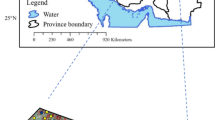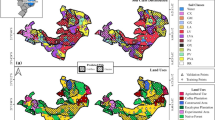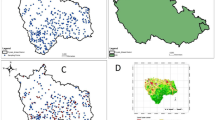Abstract
In developing countries, the use of proximal and remotely sensed data is of critical importance as a less expensive means of obtaining soils information. While proximal sensor approaches such as portable X-ray fluorescence (pXRF) spectrometry are becoming increasingly used to predict soil properties worldwide, remotely sensed data has also been used for terrain analysis in recent decades with the aid of powerful interpretive algorithms. The aims of this work were to apply a random forest algorithm to model and predict the available contents of Fe, Cu, Mn, and Zn from pXRF data in addition to terrain attributes (TAs) with 5 and 10 m spatial resolution and parent material information. The data were used separately and together in an area with high variability of parent materials. Soil samples (n = 153) were collected, analyzed by pXRF, and subjected to laboratory analyses to determine the available contents of Fe, Cu, Mn, and Zn. Twelve TAs were generated from digital elevation models (DEM). These data were divided into five datasets (or random forest inputs): pXRF data; TA 5 m data; TA 10 m; pXRF + TA 5 m; and pXRF + TA 10 m. Predictions were performed to assess the importance of such variables. Models were validated with an independent set of samples. Finally, the best models were spatially rendered to cover the entire study area and maps were also validated. The combination of pXRF data and TA covariates in addition to parent material information allowed accurate predictions of available Fe, Mn, Cu, and Zn through the random forest algorithm. Parent material information improved the predictions. Pixel size of 10 m resolution promoted better results than 5 m resolution. Available Fe contents were better predicted using only TA data. For the spatial prediction of available micronutrients, validation of maps resulted in R2 of 0.88, RMSE of 59.97 mg kg−1 and ME of 24.00 mg kg−1 for Fe; 0.85, 29.65 mg kg−1, 9.70 mg kg−1 for Mn, 0.64, 3.11 mg kg−1, 0.71 mg kg−1 for Zn and 0.82, 1.17 mg kg−1, 0.43 mg kg−1 for Cu, respectively. Available micronutrient contents can be accurately predicted using pXRF data in association with terrain and parent material information.





Similar content being viewed by others
References
Adhikari, K., Kheir, R. B., Greve, M. B., Bøcher, P. K., Malone, B. P., Minasny, B., et al. (2013). High-resolution 3-D mapping of soil texture in Denmark. Soil Science Society of America Journal, 77(3), 860. https://doi.org/10.2136/sssaj2012.0275.
Akpa, S. I. C., Odeh, I. O. A., Bishop, T. F. A., & Hartemink, A. E. (2014). Digital mapping of soil particle-size fractions for Nigeria. Soil Science Society of America Journal, 78(6), 1953–1966. https://doi.org/10.2136/sssaj2014.05.0202.
Araujo, M. A., Pedroso, A. V., Amaral, D. C., & Zinn, Y. L. (2014). Paragênese mineral de solos desenvolvidos de diferentes litologias na região sul de Minas Gerais. Revista Brasileira de Ciencia do Solo, 38(1), 11–25. https://doi.org/10.1590/S0100-06832014000100002.
Arrouays, D., Lagacherie, P., & Hartemink, A. E. (2017). Digital soil mapping across the globe. Geoderma Regional, 9, 1–4. https://doi.org/10.1016/j.geodrs.2017.03.002.
Bhering, S. B., da Chagas, C., Junior, W., Pereira, N. R., Filho, B. C., & Pinheiro, H. S. K. (2016). Mapeamento digital de areia, argila e carbono orgânico por modelos Random Forest sob diferentes resoluções espaciais. Pesquisa Agropecuaria Brasileira, 51(9), 1359–1370. https://doi.org/10.1590/S0100-204X2016000900035.
Bishop, T. F. A., Horta, A., & Karunaratne, S. B. (2015). Validation of digital soil maps at different spatial supports. Geoderma, 242, 238–249.
Borghi, E., Avanzi, J. C., Bortolon, L., Luchiari Junior, A., & Bortolon, E. S. O. (2016). Adoption and use of precision agriculture in Brazil: Perception of growers and service dealership. Journal of Agricultural Science, 8(11), 89. https://doi.org/10.5539/jas.v8n11p89.
Breiman, L. (2001). Random forests. Machine Learning, 45(1), 5–32. https://doi.org/10.1023/A:1010933404324.
Breiman, L., Friedman, J., Stone, C. J., & Olshen, R. A. (1984). Classification and regression trees (1st ed.). New York: Chapman and Hall/CRC.
Camargo, F. A. D. O., Santos, G. D. A., & Zonta, E. (1999). Alterações eletroquímicas em solos inundados. Ciência Rural, 29(1), 171–180. https://doi.org/10.1590/S0103-84781999000100032.
Carvalho Junior, W., Calderano Filho, B., Chagas, C. D. S., Bhering, S. B., Pereira, N. R., & Pinheiro, H. S. K. (2016). Regressão linear múltipla e modelo Random Forest para estimar a densidade do solo em áreas montanhosas. Pesquisa Agropecuaria Brasileira, 51(9), 1428–1437. https://doi.org/10.1590/s0100-204x2016000900041.
Cavazzi, S., Corstanje, R., Mayr, T., Hannam, J., & Fealy, R. (2013). Are fine resolution digital elevation models always the best choice in digital soil mapping? Geoderma, 195–196, 111–121. https://doi.org/10.1016/j.geoderma.2012.11.020.
Chakraborty, S., Man, T., Paulette, L., Deb, S., Li, B., Weindorf, D. C., et al. (2017). Rapid assessment of smelter/mining soil contamination via portable X-ray fluorescence spectrometry and indicator kriging. Geoderma, 306(June), 108–119. https://doi.org/10.1016/j.geoderma.2017.07.003.
Collard, F., Kempen, B., Heuvelink, G. B. M., Saby, N. P., Richer de Forges, A. C., Lehmann, S., et al. (2014). Refining a reconnaissance soil map by calibrating regression models with data from the same map (Normandy, France). Geoderma Regional, 1, 21–30. https://doi.org/10.1016/j.geodrs.2014.07.001.
Conrad, O., Bechtel, B., Bock, M., Dietrich, H., Fischer, E., Gerlitz, L., et al. (2015). System for Automated Geoscientific Analyses (SAGA) v. 2.1.4. Geoscientific Model Development, 8(7), 1991–2007. https://doi.org/10.5194/gmd-8-1991-2015.
Curi, N., Silva, S. H. G., Poggere, G. C., & de Menezes, M. D. (2017). Mapeamento de solos e magnetismo no campus da UFLA como traçadores ambientais (1st ed.). Lavras: Editora UFLA.
da Chagas, S. C., de Carvalho Junior, W., Bhering, S. B., & Calderano Filho, B. (2016). Spatial prediction of soil surface texture in a semiarid region using random forest and multiple linear regressions. Catena, 139, 232–240. https://doi.org/10.1016/j.catena.2016.01.001.
Dantas, A. A. A., de Carvalho, L. G., & Ferreira, E. (2007). Classificação e tendências climáticas em Lavras, MG. Ciência e Agrotecnologia, 31(6), 1862–1866. https://doi.org/10.1590/S1413-70542007000600039.
De Menezes, M. D., Silva, S. H. G., De Mello, C. R., Owens, P. R., & Curi, N. (2016). Spatial prediction of soil properties in two contrasting physiographic regions in Brazil. Scientia Agricola, 73(3), 274–285. https://doi.org/10.1590/0103-9016-2015-0071.
de Menezes, M. D., Silva, S. H. G., de Mello, C. R., Owens, P. R., & Curi, N. (2018). Knowledge-based digital soil mapping for predicting soil properties in two representative watersheds. Scientia Agricola, 75(2), 144–153. https://doi.org/10.1590/1678-992x-2016-0097.
Duda, B. M., Weindorf, D. C., Chakraborty, S., Li, B., Man, T., Paulette, L., et al. (2017). Soil characterization across catenas via advanced proximal sensors. Geoderma, 298, 78–91. https://doi.org/10.1016/j.geoderma.2017.03.017.
Fageria, N., & Stone, L. (2008). Micronutrient deficiency problems in South America. In Brian J. Alloway (Ed.), Micronutrient deficiencies in global crop production (pp. 245–266). Dordrecht: Springer.
Florinsky, I., Eilers, R., Manning, G., & Fuller, L. (2002). Prediction of soil properties by digital terrain modelling. Environmental Modelling & Software, 17(3), 295–311. https://doi.org/10.1016/S1364-8152(01)00067-6.
Forkuor, G., Hounkpatin, O. K. L., Welp, G., & Thiel, M. (2017). High resolution mapping of soil properties using remote sensing variables in South-Western Burkina Faso: A comparison of machine learning and multiple linear regression models. PLoS ONE, 12(1), e0170478. https://doi.org/10.1371/journal.pone.0170478.
Gessler, P. E., Moore, I. D., McKenzie, N. J., & Ryan, P. J. (1995). Soil-landscape modelling and spatial prediction of soil attributes. International journal of geographical information systems, 9(4), 421–432. https://doi.org/10.1080/02693799508902047.
Giasson, E., Clarke, R. T., Inda Junior, A. V., Merten, G. H., & Tornquist, C. G. (2006). Digital soil mapping using multiple logistic regression on terrain parameters in southern Brazil. Scientia Agricola. https://doi.org/10.1590/S0103-90162006000300008.
Gray, J. M., Bishop, T. F. A., & Wilford, J. R. (2016). Lithology and soil relationships for soil modelling and mapping. Catena, 147, 429–440. https://doi.org/10.1016/j.catena.2016.07.045.
Hengl, T. (2006). Finding the right pixel size. Computers & Geosciences, 32(9), 1283–1298. https://doi.org/10.1016/j.cageo.2005.11.008.
Hengl, T., Leenaars, J. G. B., Shepherd, K. D., Walsh, M. G., Heuvelink, G. B. M., Mamo, T., et al. (2017). Soil nutrient maps of Sub-Saharan Africa: Assessment of soil nutrient content at 250 m spatial resolution using machine learning. Nutrient Cycling in Agroecosystems, 109(1), 77–102. https://doi.org/10.1007/s10705-017-9870-x.
Heung, B., Ho, H. C., Zhang, J., Knudby, A., Bulmer, C. E., & Schmidt, M. G. (2016). An overview and comparison of machine-learning techniques for classification purposes in digital soil mapping. Geoderma, 265, 62–77. https://doi.org/10.1016/j.geoderma.2015.11.014.
Horta, A., Malone, B., Stockmann, U., Minasny, B., Bishop, T. F., et al. (2015). Potential of integrated field spectroscopy and spatial analysis for enhanced assessment of soil contamination: A prospective review. Geoderma, 241–242, 180–209. https://doi.org/10.1016/j.geoderma.2014.11.024.
Hunt, A. M. W., & Speakman, R. J. (2015). Portable XRF analysis of archaeological sediments and ceramics. Journal of Archaeological Science, 53, 628–638. https://doi.org/10.1016/j.jas.2014.11.031.
Jackson, M. L. (1958). Soil chemical analysis (1st ed.). Englewood Cliffs: Prentice-Hall Inc.
Jakob, S., Gloaguen, R., & Laukamp, C. (2016). Remote sensing-based exploration of structurally-related mineralizations around Mount Isa, Queensland, Australia. Remote Sensing. https://doi.org/10.3390/rs8050358.
Kämpf, N., Marques, J. J., & Curi, N. (2012). Mineralogia de Solos Brasileiros. In Pedologia Fundamentos (p. 343). Viçosa, MG: SBCS.
Lacerda, M. P. C., Andrade, H., & Quemeneur, J. J. G. (2002). Pedogeoquimica em perfis de alteração na região de Lavras (MG)—Elementos maiores—óxidos constituintes. Revista Brasileira de Ciência do Solo, 26(3), 87–102.
Lagacherie, P., & McBratney, A. B. (2006). Spatial soil information systems and spatial soil inference systems: perspectives for digital soil mapping. In P. Lagacherie, A. B. McBratney, & M. Voltz (Eds.), Digital soil mapping an introductory perspective (p. 658). Amsterdam: Elsevier.
Lecours, V., Devillers, R., Simms, A. E., Lucieer, V. L., & Brown, C. J. (2017). Towards a framework for terrain attribute selection in environmental studies. Environmental Modelling and Software, 89, 19–30. https://doi.org/10.1016/j.envsoft.2016.11.027.
Liaw, A., & Wiener, M. (2002). Classification and Regression by randomForest. R News, 2, 18–22. https://doi.org/10.1023/A:1010933404324.
Lopes, A. S., & Guilherme, L. R. G. (2016). A career perspective on soil management in the Cerrado region of Brazil. Advances in Agronomy, 137, 1–72. https://doi.org/10.1016/bs.agron.2015.12.004.
Marques, J., Jr., Curi, N., & Lima, J. (1992). Evolução diferenciada de Latossolo Vermelho-Amarelo e Latossolo Vermelho em função da litologia gnáissica na região de Lavras (MG). Revista Brasileira de Ciência do Solo, 16, 235–240.
Mashimbye, Z. E., De Clercq, W. P., & Van Niekerk, A. (2014). An evaluation of digital elevation models (DEMs) for delineating land components. Geoderma, 213, 312–319. https://doi.org/10.1016/j.geoderma.2013.08.023.
Maynard, J. J., & Johnson, M. G. (2014). Scale-dependency of LiDAR derived terrain attributes in quantitative soil-landscape modeling: Effects of grid resolution vs. neighborhood extent. Geoderma, 230–231, 29–40. https://doi.org/10.1016/j.geoderma.2014.03.021.
McBratney, A. B., Mendonça Santos, M. L., & Minasny, B. (2003). On digital soil mapping. Geoderma. https://doi.org/10.1016/s0016-7061(03)00223-4.
McGladdery, C., Weindorf, D. C., Chakraborty, S., Li, B., Paulette, L., Podar, D., et al. (2018). Elemental assessment of vegetation via portable X-ray fluorescence (PXRF) spectrometry. Journal of Environmental Management, 210, 210–225.
Mehlich, A. (1953). Determination of P, Ca, Mg, K, Na and NH4 (p. 195). Raleigh: North Carolina Soil Testing Division.
Mokarram, M., & Hojati, M. (2017). Morphometric analysis of stream as one of resources for agricultural lands irrigation using high spatial resolution of digital elevation model (DEM). Computers and Electronics in Agriculture, 142, 190–200. https://doi.org/10.1016/j.compag.2017.09.001.
Moore, I. D., Gessler, P. E., Nielsen, G. A., & Peterson, G. A. (1993). Soil attribute prediction using terrain analysis. Soil Science Society of America Journal, 57(2), 443–452. https://doi.org/10.2136/sssaj1993.572NPb.
Paulette, L., Man, T., Weindorf, D. C., & Person, T. (2015). Rapid assessment of soil and contaminant variability via portable x-ray fluorescence spectroscopy: Copşa Mică, Romania. Geoderma, 243–244, 130–140. https://doi.org/10.1016/j.geoderma.2014.12.025.
Pearson, D., Chakraborty, S., Duda, B., Li, B., Weindorf, D. C., Deb, S., et al. (2017). Water analysis via portable X-ray fluorescence spectrometry. Journal of Hydrology, 544, 172–179. https://doi.org/10.1016/j.jhydrol.2016.11.018.
Pelegrino, M. H. P., Silva, S. H. G., de Menezes, M. D., da Silva, E., Owens, P. R., & Curi, N. (2016). Mapping soils in two watersheds using legacy data and extrapolation for similar surrounding areas. Ciência e Agrotecnologia, 40(5), 534–546. https://doi.org/10.1590/1413-70542016405011416.
Penížek, V., Zádorová, T., Kodešová, R., & Vaněk, A. (2016). Influence of elevation data resolution on spatial prediction of colluvial soils in a luvisol region. PLoS ONE, 11(11), 1–18. https://doi.org/10.1371/journal.pone.0165699.
Peters, J., De Baets, B., Verhoest, N. E. C., Samson, R., Degroeve, S., Becker, P. De, et al. (2007). Random forests as a tool for ecohydrological distribution modelling. Ecological Modelling, 207(2–4), 304–318. https://doi.org/10.1016/j.ecolmodel.2007.05.011.
Reidinger, S., Ramsey, M. H., & Hartley, S. E. (2012). Rapid and accurate analyses of silicon and phosphorus in plants using a portable X-ray fluorescence spectrometer. New Phytologist, 195(3), 699–706. https://doi.org/10.1111/j.1469-8137.2012.04179.x.
Resende, M., Curi, N., Rezende, S. B., Corrêa, G. F., & Ker, J. C. (2014). Pedologia: Base para distinção de ambientes (6th ed.). Lavras: Editora UFLA.
Ribeiro, B. T., Silva, S. H. G., Silva, E. A., & Guilherme, L. R. G. (2017). Portable X-ray fluorescence (pXRF) applications in tropical Soil Science. Ciência e Agrotecnologia, 41(3), 245–254. https://doi.org/10.1590/1413-70542017413000117.
Ryan, J. G., Shervais, J. W., Li, Y., Reagan, M. K., Li, H. Y., Heaton, D., et al. (2017). Application of a handheld X-ray fluorescence spectrometer for real-time, high-density quantitative analysis of drilled igneous rocks and sediments during IODP Expedition 352. Chemical Geology, 451, 55–66. https://doi.org/10.1016/j.chemgeo.2017.01.007.
Shaetzl, R., & Anderson, S. (2005). Soils: Genesis and geomorphology (1st ed.). New York: Cambridge University Press.
Shangguan, W., Hengl, T., de Jesus, J. M., Yuan, H., & Dai, Y. (2014). Mapping the global depth to bedrock for land suface modeling. Journal of Advances in Modeling Earth Systems, 6, 513–526. https://doi.org/10.1002/2013MS000282.Received.
Sharma, A., Weindorf, D. C., Man, T., Aldabaa, A. A. A., & Chakraborty, S. (2014). Characterizing soils via portable X-ray fluorescence spectrometer: 3. Soil reaction (pH). Geoderma, 232–234, 141–147. https://doi.org/10.1016/j.geoderma.2014.05.005.
Sharma, A., Weindorf, D. C., Wang, D., & Chakraborty, S. (2015). Characterizing soils via portable X-ray fluorescence spectrometer: 4. Cation exchange capacity (CEC). Geoderma, 239, 130–134. https://doi.org/10.1016/j.geoderma.2014.10.001.
Silva, S. H. G., de Menezes, M. D., de Mello, C. R., de Góes, H. T. P., Owens, P. R., & Curi, N. (2016a). Geomorphometric tool associated with soil types and properties spatial variability at watersheds under tropical conditions. Scientia Agricola. https://doi.org/10.1590/0103-9016-2015-0293.
Silva, S. H. G., Poggere, G. C., de Menezes, M. D., Carvalho, G. S., Guilherme, L. R. G., & Curi, N. (2016b). Proximal sensing and digital terrain models applied to digital soil mapping and modeling of Brazilian Latosols (Oxisols). Remote Sensing, 8, 614–635. https://doi.org/10.3390/rs8080614.
Silva, S. H. G., Teixeira, A. F. S., Menezes, M. D., Guilherme, L. R. G., de Moreira, F. M., & Curi, N. (2017). Multiple linear regression and random forest to predict and map soil properties using data from portable X-ray fluorescence analyzer (pXRF). Ciência e Agrotecnologia, 41(6), 648–664.
Smith, M. P., Zhu, X., Burt, J. E., & Stiles, C. (2006). The effects of DEM resolution and neighborhood size on digital soil survey. Geoderma, 137(1–2), 58–69. https://doi.org/10.1016/j.geoderma.2006.07.002.
Soil Survey Staff. (2014). Keys to soil taxonomy (12th ed.). USDA-NRCS. Retrieved from http://www.nrcs.usda.gov/Internet/FSE_DOCUMENTS/nrcs142p2_051546.pdf
Stockmann, U., Cattle, S. R., Minasny, B., & McBratney, A. B. (2016). Utilizing portable X-ray fluorescence spectrometry for in-field investigation of pedogenesis. Catena, 139, 220–231. https://doi.org/10.1016/j.catena.2016.01.007.
Thompson, J., Roecker, S., Grunwald, S., & Owens, P. R. (2012). Digital soil mapping: Interactions with and applications for hydropedology. Hydropedology. https://doi.org/10.1016/B978-0-12-386941-8.00021-6.
Weindorf, D. C., Bakr, N., & Zhu, Y. (2014). Chapter One—advances in portable X-ray fluorescence (PXRF) for environmental, pedological, and agronomic applications. In A. Sparks (Ed.), Advances in agronomy (pp. 1–45). New York: Academic Press.
Weindorf, D. C., Zhu, Y., Haggard, B., Lofton, J., Chakraborty, S., Bakr, N., et al. (2012). Enhanced pedon horizonation using portable X-ray fluorescence spectrometry. Soil Science Society of America Journal, 76(2), 522–531. https://doi.org/10.2136/sssaj2011.0174.
Weindorf, D. C., & Chakraborty, S. (2016). Portable X-ray fluorescence spectrometry analysis of soils. In D. Hirmas (Ed.), Methods of soil analysis (pp. 1–8). Madison: Soil Science Society of America.
Zhu, Y., Weindorf, D. C., & Zhang, W. (2011). Characterizing soils using a portable X-ray fluorescence spectrometer: 1. Soil texture. Geoderma, 167–168, 167–177. https://doi.org/10.1016/j.geoderma.2011.08.010.
Zhu, H., Zhao, Y., Nan, F., Duan, Y., & Bi, R. (2016). Relative influence of soil chemistry and topography on soil available micronutrients by structural equation modeling, 16(4), 1038–1051. https://doi.org/10.4067/S0718-95162016005000076.
Acknowledgements
The authors would like to thank CNPq, CAPES and FAPEMIG Brazilian agencies for providing the financial support necessary for carrying out this work. The authors gratefully acknowledge the contributions of the BL Allen Endowment in Pedology at Texas Tech University in conducting this research.
Author information
Authors and Affiliations
Corresponding author
Rights and permissions
About this article
Cite this article
Pelegrino, M.H.P., Weindorf, D.C., Silva, S.H.G. et al. Synthesis of proximal sensing, terrain analysis, and parent material information for available micronutrient prediction in tropical soils. Precision Agric 20, 746–766 (2019). https://doi.org/10.1007/s11119-018-9608-z
Published:
Issue Date:
DOI: https://doi.org/10.1007/s11119-018-9608-z




